Readers have a wide selection of recently published books about friendship from which to choose. The books included here explore all types of best friend relationships. For younger readers, there are picture books about an intergenerational friendship, unlikely friendships, and the loss of a friend through death as well as novels about making new friends and changing relationships that come as best friends move in different directions. The novels for older readers deal with the importance of friends in helping each other with difficult life problems and the parting of friends as misunderstandings develop and they come to realize that they may not be able to restore their friendship (or want to do so).
Ages 4–8
The Girl With the Parrot on Her Head. Daisy Hirst. 2016. Candlewick.
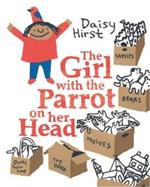 When Isabel gets over being angry and lonely after her best friend Simon moves away, she decides she is OK being on her own. After all, she has the parrot on her head; she doesn’t need friends. Akin to an adult deciding to tackle the long overdue job of cleaning up the garage, Isabel decides to organize her room and, with the help of the parrot, sorts items—castles, bears, broken umbrellas, wolves—into boxes. Parrot (and secretly Isabel, too) worries that the wolf hanging out over the edge is too big for the wolf box. Isabel sets out to find a bigger box to contain the big wolf. The box she finds is occupied by a boy named Chester, who has ideas about what to do with the wolf and also plenty of ideas as to how to use the big box and items in Isabel’s room. Hirst’s screen-printed illustrations are as charming and imaginative as new friends Isabel and Chester are in their play.
When Isabel gets over being angry and lonely after her best friend Simon moves away, she decides she is OK being on her own. After all, she has the parrot on her head; she doesn’t need friends. Akin to an adult deciding to tackle the long overdue job of cleaning up the garage, Isabel decides to organize her room and, with the help of the parrot, sorts items—castles, bears, broken umbrellas, wolves—into boxes. Parrot (and secretly Isabel, too) worries that the wolf hanging out over the edge is too big for the wolf box. Isabel sets out to find a bigger box to contain the big wolf. The box she finds is occupied by a boy named Chester, who has ideas about what to do with the wolf and also plenty of ideas as to how to use the big box and items in Isabel’s room. Hirst’s screen-printed illustrations are as charming and imaginative as new friends Isabel and Chester are in their play.
Harry and Walter. Kathy Stinson. Ill. Qin Leng. 2016. Annick.
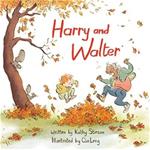 Four-year-old Harry and 92-year-old Walter are neighbors and best friends. They enjoy doing things together until the day a For Sale sign goes up in front of Harry’s house. Harry cries; he doesn’t want to move. Walter tries to console Harry. “Things change. I might have to move someday, too.” Although his new house is nice and he even has a tree house, Harry misses Walter. A year later, folding origami birds like he did with Walter, Harry tosses a paper bird from his tree house—and it flies back to him. Harry looks down and sees Walter. His old friend has moved into an apartment down the street. Leng’s playful, expressive watercolor illustrations complement this warm story of an enduring intergenerational friendship.
Four-year-old Harry and 92-year-old Walter are neighbors and best friends. They enjoy doing things together until the day a For Sale sign goes up in front of Harry’s house. Harry cries; he doesn’t want to move. Walter tries to console Harry. “Things change. I might have to move someday, too.” Although his new house is nice and he even has a tree house, Harry misses Walter. A year later, folding origami birds like he did with Walter, Harry tosses a paper bird from his tree house—and it flies back to him. Harry looks down and sees Walter. His old friend has moved into an apartment down the street. Leng’s playful, expressive watercolor illustrations complement this warm story of an enduring intergenerational friendship.
Hello, Hippo! Goodbye, Bird! Kristyn Crow. Ill. Poly Bernatene. 2016. Alfred A. Knopf/Random House.
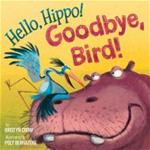 “Hello, Hippo!” A pesky, skinny, long-legged bird’s persistent attempts at befriending a grumpy, plump hippo (showing how he can be a hat, a “hippopota-mustache,” or an umbrella and offering to tell jokes) elicit only “Errrrumphs” and a “Goodbye, Bird!” Bird departs and Hippo delights in being alone. Even after Bird comes to Hippo’s rescue when he is attacked by a swarm of wasps by gobbling up the insects, Hippo still gives Bird a dismissive send off. “For the last time—GOODBYE, BIRD!” Then, in a big thunderstorm (“KA-BOOM!), Hippo cries out for Bird. Does he need Bird to be an umbrella or does he want companionship? The answer comes on the last double-page spread that shows the two frolicking together in the water.
“Hello, Hippo!” A pesky, skinny, long-legged bird’s persistent attempts at befriending a grumpy, plump hippo (showing how he can be a hat, a “hippopota-mustache,” or an umbrella and offering to tell jokes) elicit only “Errrrumphs” and a “Goodbye, Bird!” Bird departs and Hippo delights in being alone. Even after Bird comes to Hippo’s rescue when he is attacked by a swarm of wasps by gobbling up the insects, Hippo still gives Bird a dismissive send off. “For the last time—GOODBYE, BIRD!” Then, in a big thunderstorm (“KA-BOOM!), Hippo cries out for Bird. Does he need Bird to be an umbrella or does he want companionship? The answer comes on the last double-page spread that shows the two frolicking together in the water.
Ida, Always. Carol Levis. Ill. Charles Santoso. 2016. Atheneum/Simon & Schuster.
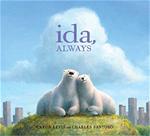 A thoughtfully worded text and softly colored digital paintings explore the strong, caring friendship of Gus and Ida, polar bears living in a zoo. When Ida becomes ill, Gus becomes her steadfast companion. Then Ida dies. Gus is lonely but sustained by pleasant memories of his friendship with Ida. Although he is now alone, he can still sit in the spot where Ida liked to soak in the sun and listen to the hum of the city. “And Ida is right there. Always.” Based on the true story of polar bears Ida and Gus who lived in the Central Park Zoo in New York City, Ida, Always offers a gentle lesson on friendship and loss.
A thoughtfully worded text and softly colored digital paintings explore the strong, caring friendship of Gus and Ida, polar bears living in a zoo. When Ida becomes ill, Gus becomes her steadfast companion. Then Ida dies. Gus is lonely but sustained by pleasant memories of his friendship with Ida. Although he is now alone, he can still sit in the spot where Ida liked to soak in the sun and listen to the hum of the city. “And Ida is right there. Always.” Based on the true story of polar bears Ida and Gus who lived in the Central Park Zoo in New York City, Ida, Always offers a gentle lesson on friendship and loss.
Monkey and Elephant and the Babysitting Adventure (Monkey and Elephant #5). Carole Lexa Schaefer. Ill. Galia Bernstein. 2016. Candlewick.
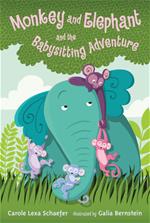 Best friends Monkey and Elephant take on something new when they agree to babysit Cousin MeeMee’s three babies, and they are not certain they will be successful. Perhaps they need to establish some rules for dealing with the little monkeys. Their babysitting job turns out to be an adventure that requires the hasty addition of Rule Number 4, “Always keep babies safe,” which they enforce by scaring off three riff raff wildcats that are intent on making the three baby monkeys their snack. This final book in the easy reader Monkey and Elephant series ends as Monkey and Elephant come up with a final rule: To always stay adventure friends —and best friends forever.
Best friends Monkey and Elephant take on something new when they agree to babysit Cousin MeeMee’s three babies, and they are not certain they will be successful. Perhaps they need to establish some rules for dealing with the little monkeys. Their babysitting job turns out to be an adventure that requires the hasty addition of Rule Number 4, “Always keep babies safe,” which they enforce by scaring off three riff raff wildcats that are intent on making the three baby monkeys their snack. This final book in the easy reader Monkey and Elephant series ends as Monkey and Elephant come up with a final rule: To always stay adventure friends —and best friends forever.
Ages 9–11
The Pages Between Us. Lindsey Leavitt & Robin Mellom. Ill. Abby Dening. 2016. Harper/HarperCollins.
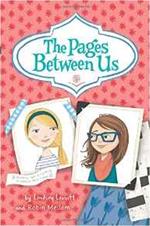 Having vowed to remain best friends forever, Olivia and Piper enter middle school and find that they will be sharing only one class. They make plans to stay connected by passing a notebook back and forth during the day. In the notebook, the two girls communicate with lengthy notes, frequently ending with “grateful for” lists; taped-in invitations and clippings; blog postings by a gossipy classmate; and doodles. Hoping to become more socially involved, they try out some after-school clubs. The problem comes when the two friends find they have very different extracurricular interests. Olivia and Piper’s involvement in separate activities is reflected in changes in the frequency and nature of their entries in the notebook as they come to terms with how to stay the best of friends in spite of diverging interests.
Having vowed to remain best friends forever, Olivia and Piper enter middle school and find that they will be sharing only one class. They make plans to stay connected by passing a notebook back and forth during the day. In the notebook, the two girls communicate with lengthy notes, frequently ending with “grateful for” lists; taped-in invitations and clippings; blog postings by a gossipy classmate; and doodles. Hoping to become more socially involved, they try out some after-school clubs. The problem comes when the two friends find they have very different extracurricular interests. Olivia and Piper’s involvement in separate activities is reflected in changes in the frequency and nature of their entries in the notebook as they come to terms with how to stay the best of friends in spite of diverging interests.
Raymie Nightingale. Kate DiCamillo. 2016. Candlewick.
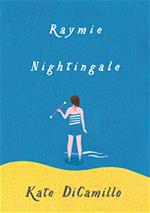 It’s the fifth of June in 1975 and 10-year-old Raymie Clarke is dealing with a great tragedy. Two days earlier, Raymie’s father, Jim Clarke of Clarke Family Insurance, ran off with a dental hygienist, disgracing himself, and leaving her fatherless. Raymie, however, has a plan: She will win the Little Miss Central Florida Tire contest, get her picture in the paper, her father will see it, and come home to his famous daughter. Needing a talent for the contest, Raymie enrolls in baton-twirling class and meets two other girls with special interests in the contest, Louisiana Elefante, who needs the cash prize, and Beverly Tapsinski, who plans to sabotage the contest. The three very different girls become friends and set out to do some good deeds (a requirement of the contest), which involve them with interesting townspeople and unexpectedly complicated adventures. Not all goes as planned but, with friendships solidified, their futures look brighter. DiCamillo offers young readers a warm and humorous story with characters who are just the kind of good friends they’d like to have.
It’s the fifth of June in 1975 and 10-year-old Raymie Clarke is dealing with a great tragedy. Two days earlier, Raymie’s father, Jim Clarke of Clarke Family Insurance, ran off with a dental hygienist, disgracing himself, and leaving her fatherless. Raymie, however, has a plan: She will win the Little Miss Central Florida Tire contest, get her picture in the paper, her father will see it, and come home to his famous daughter. Needing a talent for the contest, Raymie enrolls in baton-twirling class and meets two other girls with special interests in the contest, Louisiana Elefante, who needs the cash prize, and Beverly Tapsinski, who plans to sabotage the contest. The three very different girls become friends and set out to do some good deeds (a requirement of the contest), which involve them with interesting townspeople and unexpectedly complicated adventures. Not all goes as planned but, with friendships solidified, their futures look brighter. DiCamillo offers young readers a warm and humorous story with characters who are just the kind of good friends they’d like to have.
Ages 12–14
After the Woods. Kim Savage. 2016. Farrar Straus Giroux.
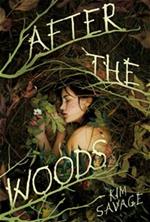 One year after what the press calls the Shiverton Abduction, Julia, who was kidnapped by a man named Donald Jessup while running in the woods with her best friend, Liv, is still trying to remember what happened during the two days before she escaped. Liv was the intended victim, and Julia’s attack on knife-wielding Donald had allowed her friend to escape. Now Julia can’t understand Liv’s we-survived-so-get-over-it attitude. Jessup has committed suicide in his jail cell, another girl’s body has been found in the same wood, and Liv is behaving oddly. The plot of this psychological thriller becomes increasingly more twisted as Julia begins to recover memories of her abduction and uncovers Liv’s secrets, secrets that make her realize that Liv is not the person she thought she was.
One year after what the press calls the Shiverton Abduction, Julia, who was kidnapped by a man named Donald Jessup while running in the woods with her best friend, Liv, is still trying to remember what happened during the two days before she escaped. Liv was the intended victim, and Julia’s attack on knife-wielding Donald had allowed her friend to escape. Now Julia can’t understand Liv’s we-survived-so-get-over-it attitude. Jessup has committed suicide in his jail cell, another girl’s body has been found in the same wood, and Liv is behaving oddly. The plot of this psychological thriller becomes increasingly more twisted as Julia begins to recover memories of her abduction and uncovers Liv’s secrets, secrets that make her realize that Liv is not the person she thought she was.
The Last Place on Earth. Carol Snow. 2016. Henry Holt.
 Daisy’s best friend, Henry Hawking, and his parents have suddenly disappeared. She knows Henry would never leave without saying goodbye. After several days of worrying, Daisy breaks into the house of the security-conscious Hawkings and discovers a note left on Henry’s desk: SAVE ME. Some further sleuthing, abetted by her brother, Peter, and receipt of a cryptic text from an unknown number leads Daisy into the wilderness of California’s Los Padres National Forest. She finds Henry in a compound of “doomsday preppers,” who are intent on surviving a probable teotwawki (pronounced tee-ought-walkie and standing for “the end of the world as we know it”). Daisy’s wit and sarcasm enlivens this story of courage, loyalty to friends, and love of family as it shifts from Daisy’s reunion with Henry to efforts to reunite with her mother and brother once she learns that the deadly Madagascar plague is a real threat to survival.
Daisy’s best friend, Henry Hawking, and his parents have suddenly disappeared. She knows Henry would never leave without saying goodbye. After several days of worrying, Daisy breaks into the house of the security-conscious Hawkings and discovers a note left on Henry’s desk: SAVE ME. Some further sleuthing, abetted by her brother, Peter, and receipt of a cryptic text from an unknown number leads Daisy into the wilderness of California’s Los Padres National Forest. She finds Henry in a compound of “doomsday preppers,” who are intent on surviving a probable teotwawki (pronounced tee-ought-walkie and standing for “the end of the world as we know it”). Daisy’s wit and sarcasm enlivens this story of courage, loyalty to friends, and love of family as it shifts from Daisy’s reunion with Henry to efforts to reunite with her mother and brother once she learns that the deadly Madagascar plague is a real threat to survival.
Ages 15+
The Year We Fell Apart. Emily Martin. 2016. Simon Pulse/Simon & Schuster.
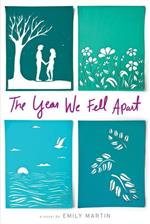 A year ago, Harper destroyed her relationship with Declan, her best friend/boyfriend. Now Declan is back home for the summer after a year of boarding school, but for Harper was a year of destructive behavior involving drinking, drugs, and sex that has destroyed her reputation at school and in family relationships. It appears Declan has moved on since their breakup and wants nothing to do with her. Over the summer, Harper wants to salvage their relationship and to make Declan understand and forgive her for the bad choices she has made, but it is not going to be easy. To move on, the two of them will need to accept that the past cannot be undone and forgive themselves and each other.
A year ago, Harper destroyed her relationship with Declan, her best friend/boyfriend. Now Declan is back home for the summer after a year of boarding school, but for Harper was a year of destructive behavior involving drinking, drugs, and sex that has destroyed her reputation at school and in family relationships. It appears Declan has moved on since their breakup and wants nothing to do with her. Over the summer, Harper wants to salvage their relationship and to make Declan understand and forgive her for the bad choices she has made, but it is not going to be easy. To move on, the two of them will need to accept that the past cannot be undone and forgive themselves and each other.
Carolyn Angus is former director of the George G. Stone Center for Children's Books, Claremont Graduate University, in California.
These reviews are submitted by members of the International Literacy Association's Children's Literature and Reading Special Interest Group (CL/R SIG) and are published weekly on Literacy Daily.